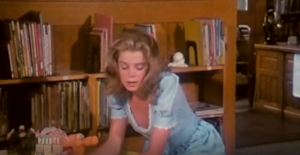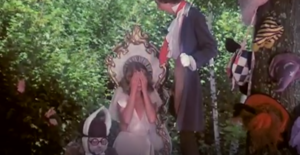content description: discussions and analysis of sexuality and porn, as well as nude screenshots from an erotic film and magazine
The hit 1865 Alice In Wonderland was adapted as early as 1866 into a widely popular musical. Caroll had a direct hand in the piece, going as far to personally design and purchase costumes for the two young girl actors in the play. In letters to the show’s playwright, he stressed the importance of avoiding “any coarseness, or anything suggestive of coarseness.” (1)
Lewis Caroll would then, no doubt, be very alarmed to learn of the 1976 production, “Alice in Wonderland: An X-Rated Musical Fantasy”.

The movie was produced by Bill Osco and Jason Williams during the 1960s-80s “golden age” of adult film and entertainment. (2) It had both softcore (explicitly sexual, but without penetration) and hardcore (penetrative) releases. Despite being massively popular and raking in millions, many of the actors and crew saw none of the profits, due to shady dealings of producer Bill Osco.
Why use a children’s story as the premise? Producer Jason Williams explained, “I thought it would be a good idea to have the polarity, the contrast. Contrast is interesting and gets your attention.” (3) This strategy is not dissimilar from Caroll’s method of using absurdity and humor.
The 1976 film revolves around an adult Alice, who argues with her boyfriend because she wants to wait until after marriage to have sex.

She sings the song, “(Guess I Was Just Too Busy) Growing Up”, in which she laments she isn’t able to properly perform adulthood (sexuality) because she repressed her childhood. It isn’t until 1976 Alice enters a dreamworld, free from consequence, that she is able to masturbate and have sex for the first time. In the end of the film, she enthusiastically has sex with her boyfriend after becoming sexually liberated during her Wonderland experiences. This is a continuation of the journey of 1865 Alice, who, after confronting her doubts about the rules of adult life in her dreamworld, achieves adulthood.
The 1976 film follows the original text’s obsession with the relation between size and identity, a powerful metaphor for puberty/sexual maturity. Both Alices grow and shrink, but 1976 Alice becomes nude as a result, marking her transition into owning her sexuality. The 1865 Alice questions her identity because of her “number of changes [in size].” (4) She also remarks on the size of the animals she meets, expressing fear and surprise.


The 1976 Alice expresses the same incongruence of identity between body/mind, as her boyfriend remarks, “Your body is grown but your mind is a child.” In typical porn fashion, 1976 Alice expresses fear and surprise when finding out how large the Mad Hatter’s penis is before performing oral sex. In both texts, size, identity, and power are interchangeable.
While the 1976 film is explicitly sexual, it simply builds on the implicit sexual themes of the original. When you put these texts in conversation with each other, they share more than they differ. Caroll may have claimed to want to avoid vulgarity, but his obsession with girlhood and children is nothing if not sexual. This sexualization of girlhood continues with the 1976 film. The Victorian age seems like the exact opposite of the heyday of adult films, but they share similar desires and strategies of speaking about them.

The brief analysis I did here couldn’t remotely come close to a full exploration of these two texts, but I hope to have begun to illuminate the surprising similarities in content, as well as the origins of their creation. Perhaps now we can see the 1865 Alice in Wonderland in a new way.
- Morton N. Cohen (ed.), The Selected Letters of Lewis Carroll, (New York, Pantheon Books, 1982), 163.
- “What Is the Rialto Report?” The Rialto Report, August 29, 2021. https://www.therialtoreport.com/what/.
- “‘Alice in Wonderland’ (1976): What really happened?” March 22, 2015. https://www.therialtoreport.com/2015/03/22/alice-in-wonderland-1976-what-really-happened/
- Lewis Caroll, The Adventures of Alice in Wonderland, (New York, Bantam Dell 1865), 40.
This is SO fascinating! I noticed, too, that there is a tendency for the porn industry to take childish things and make them sexual (e.g. school uniforms, the word “daddy” etc.). The producer’s argument about the two things being such a big contrast is interesting but it also does not elaborate further. One aspect in your analysis I found really interesting: You said that the Victorian Age is not particularly known for its sexual openness and I think that it is revealing to transfer the film onto the Victorian Era. Something that seems so innocent and prude as a children’s tale turns out to be very sexual after all. Of course, the texts that we read were not explicitly about sex but implicitly there is a lot to interpret. Just like the film did with Alice in Wonderland. This is such a compelling topic and I love your blogpost about it!